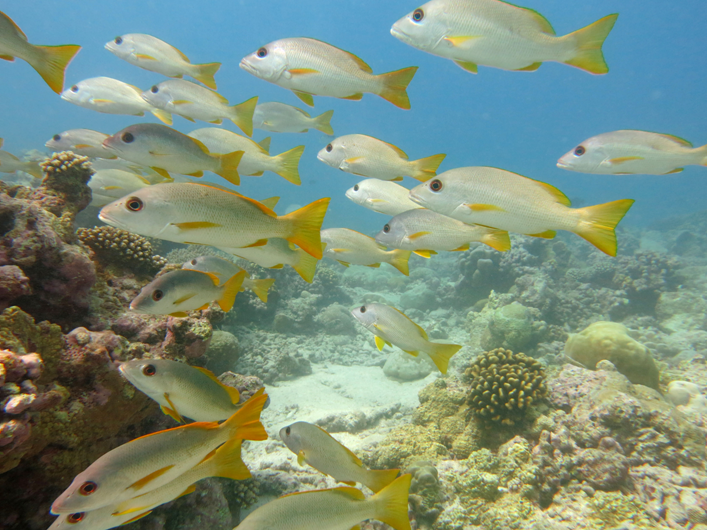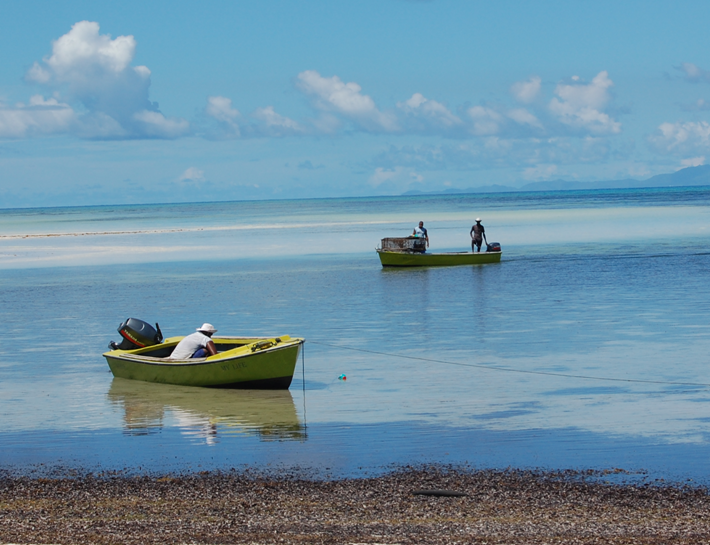- Many coral reefs have lost their top predators due to overfishing, changing the structure of their food chains.
- Researchers have found that when top predators are overfished, medium-sized predators benefit, but to the overall detriment of the ecosystem.
- Local communities worldwide depend on coral reef fisheries for income and easily accessible protein, but better management is needed for these fisheries to last.
Coral reefs may be underwater, but they are also under fire: overfishing is dramatically altering these underwater treasures. While most people never get to see these ecosystems up close, they benefit from their health. Coral reefs house a high diversity and abundance of fish that support local markets around the world. But overfishing is causing coral reefs to lose important species in fish communities, especially big predators that breed slowly.
“These species are easily overfished,” explained Nick Graham from Lancaster University who leads a team that is working to develop better fishing guidelines.
Graham’s latest study published in Current Biology suggests that coral reef fisheries managers should take an energetics perspective when looking at how to both conserve these ecosystems and maintain yields. They found when total fish biomass goes below 665 kilograms per hectare, energy is not transferred as efficiently throughout the system, damaging the ecosystem.

Food chain strain
Food chains are not only important for maintaining functions within the ecosystem – such as predation – but also energy transfers through the system. For instance, think of lions in the in the Serengeti. They are infamous top predators that keep the ecosystem healthy by picking off weak prey. Sharks in corals reefs perform similarly. However, given a dearth of data on marine top predators – like sharks – researchers hope that they can get answers about the role of marine predators and coral reef health by looking into food chains.
Food chains are typically represented as trophic pyramids. These pyramids are made up of various trophic levels, which are the positions each species holds in the food chain. In coral reefs, lower trophic levels include small fish and invertebrates. The highest tropic levels consist of fish that consume other fish, known as piscivores. These are top predators, like reef sharks, snapper, and grouper. They are slow growing species that are rapidly picked off by fisherman. But, today, few coral reefs still possess a strong population of top predators due to overfishing.
“The immediate effects are loss of food and income to fishers and the longer term effects are changes in the food web that can result in lower reef growth, inability to keep up with rising sea level and beach erosion,” Dr. Tim McClanahan, a co-author from the Wildlife Conservation Society, said.

In a paper published in 2015 in Nature, the team found that it takes on average 35 years for a reef to recover from overfishing if proper protections are put into place. Here, they locate the missing link, providing new insights to improve management policies.
Under the sea
Graham and his colleagues went to the source to see how fishing in coral reefs puts pressure on food chains. The team dove approximately 250 coral reefs in the Indian Ocean to visually survey fish populations.
The sites spanned lightly to heavily fished areas, crossing nine countries and jurisdictions, including the Chagos archipelago, the Comoros, Kenya, Madagascar, Mayotte, Mozambique, the Maldives, Seychelles, and Tanzania. They also compared areas with healthy fish populations – like the lightly fished, remote Chagos archipelago – to areas with low fish populations – like the overexploited Kenyan reefs. During these surveys, they looked at changes in trophic structure and the impact this has on energy transfer in the food chain.
At each trophic level, there is less energy available for the next level. And therefore, if a mid-trophic level is eliminated, there will be more energy available for the top trophic levels. A way to describe each trophic level is the amount of biomass that is present, which, in this case, is the total mass of a group of fish in a certain area. This number gives insight into energy storage, and how efficiently energy is transferred through the chain.

Not surprisingly, biomass at all levels of the food chain was lower in areas with greater fishing pressures, according to the researchers. In their 2015 paper, the team found that over 80 percent of coral reefs are missing at least half of their fish biomass. And biomass tends to be especially low in areas with large fish markets that are easily accessible to consumers.
Fish at the top of the food chain, like reef sharks, snapper, and grouper, were the hardest hit. The extent can be devastating. In a 2010 paper in Aquatic Conservation, they found that sharks declined by 90 percent even in lightly fished locations.
But the research team also found something unexpected this time around. The mid-trophic level fish, such as wrasses, exhibited the slowest drop. Such species actually dominated in areas with the highest fishing pressure. And thus, the average trophic level of the community actually increased in heavily fished waters.

“This finding was unexpected, as the dominant narrative for other fisheries has been a steadily declining mean trophic level as fishing pressure increases,” said Graham.
Consider if there were people in a room with different heights, and most of the taller individuals left, and some of the shorter individuals left. If most of the people that were left were of medium height, the average height of the room would still be fairly high. Because the mid-trophic level fish are showing the slowest decline, they are keeping the average high.
Their findings contradict the fishing down the food web paradigm that predicts communities will favor lower trophic level fish, like small fish and invertebrates – instead it’s mid level animals that are doing best. In fact, sea urchins replaced fish at the lower trophic levels, and sea urchins are a direct prey source for some mid-trophic level fish, like wrasse and triggerfish.
Sea urchins are important herbivores, but if they become too abundant they can cause bioerosion. This is the removal of calcium carbonate from the reef as sea urchins feed on corals. Some corals have skeletons made of calcium carbonate, and they are important because they build the foundation of reefs. Other corals use them for support. Too many sea urchins can ruin the integrity of reefs from the bottom up.

In lightly fished reefs something different happens to the food chain. Trophic pyramids acquire an hourglass shape with the highest biomass at the top and bottom trophic levels. This way energy can be passed quickly through the food chain, and avoid energy losses at mid-trophic levels. This hourglass shape is also what is expected in pristine, un-fished ecosystems.
Food for thought
Top predators – and those with the highest market values – are only maintained in lightly fished reefs. Once fish biomass goes below 665 kilograms per hectare, trophic pyramids lose the hourglass shape that allows them to transfer energy quickly and efficiently, according to the research. Below this number, the high market value species disappear, injuring not just fish populations but the fishers and local communities as well.
Fish are not only directly consumed by local fishers – they are also traded for other types of food. Reliance on fish varies greatly, depending on the community, but overall they are important to many people’s livelihood and protein intake in poor communities. Balancing thriving reefs and supporting local livelihoods has proven difficult.
The researchers argue that coral reef fisheries should consider energy transfer when creating policies and making recovery plans to better preserve ecosystem function and support the local communities.
“The key is that people are engaged in the management process and that they have options about which direction to take,” Dr. Aaron MacNeil, a co-author from Dalhousie University, said.
In another Nature paper published in 2016, the team highlighted that coral reefs thrive when there is high local engagement and sociocultural institutions in place. The greatest conservation gains are made when locals are engaged and presented with management alternatives.
“While not a fisher myself, I can imagine being in their position and preferring to work with conservation groups or managers who respect my livelihood and include me in the decision-making process,” MacNeil said.
Taking an energetics perspective and including locals might be important links to keep these fish swimming.
Citations:
Graham, N.A.J., McClanahan, T.R., MacNeil, M.A., Wilson, S.K., Cinner, J.E., Huchery, C., Holmes, T.H. (2017) Human disruption of coral reef trophic structure. Current Biology, 27, 231-236.
Cinner, J.E., Huchery, C., MacNeil, M.A., Graham, N.A.J., McClanahan, T.R., Maina, J., Maire, E., Kittinger, J.N., Hicks, C.C., Mora, C., Allison, E.H., D’Agata, S., Hoey, A., Feary, D.A., Crowder, L., Williams, I.D., Kulbicki, M., Vigliola, L., Wantiez, L., Edgar, G., Stuart-Smith, R.D., Sandin, S.A., Green, A.L., Hardt, M.J., Beger, M., Friedlander, A., Campbell, S.J., Holmes, K.E., Wilson, S.K., Brokovich, E., Brooks, A.J., Cruz-Motta, J.J., Booth, D.J., Chabanet, P., Gough, C., Tupper, M., Ferse, S.C.A., Sumaila, U.R., Mouillot, D. (2016) Bright spots among the world’s coral reefs. Nature, 535, 416–419. doi:10.1038/nature18607
MacNeil, M.A., Graham, N.A.J., Cinner, J.E., Wilson, S.K., Williams, I.D., Maina, J., Newman, S., Friedlander, A.M., Jupiter, S., Polunin, N.V.C., McClanahan, T.R., (2015) Recovery potential of the world’s coral reef fishes. Nature, 520, 341–344. doi:10.1038/nature14358
Graham, N.A.J., Spalding, M.D., Sheppard, C.R.C., (2010) Reef shark declines in remote atolls highlight the need for multifaceted conservation action. Aquatic Conservation: Marine and Freshwater Ecosystems, 20, 543-548.
